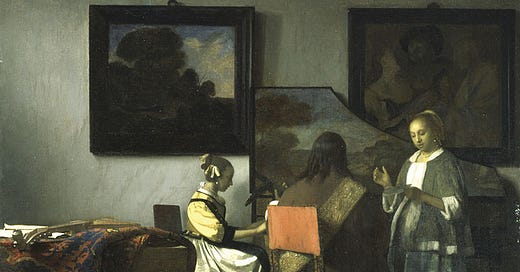The Concert is a painting which perfectly encapsulates the genius of Johannes Vermeer.
We have pale light seeping through the window - delicate realism in the objects that decorate this interior - and that inimitable sense of tender intimacy, as we meet these three figures (apparently totally unaware they are being watched) in a moment of leisure.
In fact, if we stay here long enough and listen closely - it almost feels as if we are right on the cusp of hearing a faint note of what song they are playing all together.
But sadly, this particular concert is currently not to be found in its rightful place on a museum wall.
Rather, it is at the very top of the art world’s “most wanted” list . . . having been stolen from the Isabella Stewart Gardner Museum in Boston, USA almost thirty five years ago.
Now, incidentally, this is not the only picture which is still missing from that particular art heist.
In the early hours of March 18th, 1990 - thieves managed to steal no less than thirteen artworks from the Isabella Stewart Gardner collection; including pieces by Manet, Degas, and three works by Rembrandt van Rijn, including the great man’s only known seascape “Storm on the Sea of Galilee”
But, while all of these other works are extraordinarily valuable in their own right too - when we come to Vermeer’s Concert, the loss feels even more profound.
After all, there are only 34 known works which can be firmly attributed to the man from Delft. (And in his entire career, most estimates believe he would have only painted 60 at most!)
Thus, they are already something of a rarity. But here with The Concert, we have something even more tantalizing; with many scholars believing that the figure at the centre of this work, with his back to us, is none other than Vermeer himself. (Which, if true, would make it the only known self portrait of the artist at the height of his career1)
So it is little wonder why this painting is often regarded as “the world’s most valuable stolen artwork” . . . or why the Isabella Stewart Gardner Museum still offers a $10 million reward for anyone who can find it.
But with the stakes this high - the question of who could have stolen remains a total mystery.
Admittedly, there are too many theories for us to cover here - so for any of you who may be aspiring art investigators, I’ll have to leave you to explore the range of them in your own time.
But as always with high profile art thefts - the question of whether it may have been some kind of “inside job” cannot be discounted. And other key theories also tend to link the heist to various international crime gangs, or quite possibly to the Boston Mafia.
However, despite an abundance of potential suspects . . . the FBI were unusually quick to warn that this case may be particularly difficult to resolve, due to an “astonishing lack of physical evidence”.
Thus, the case remains just as impenetrable now as it was back in 1990.
Sadly, any investigations into those Mafia links came to nothing. (Though, as you can imagine, it is a often dangerous game to be found asking too many questions in those circles anyway)
And after all these years, another element that is becoming ever more problematic is that some of the original “prime suspects” have since passed away too - so the proverbial “trail of breadcrumbs” here is already starting to wear thin.
In fact, the last time there was any significant hope of finding Vermeer’s concert was back in 1994 - when an anonymous letter arrived at the Gardner museum, claiming to be written by someone who wanted to “negotiate” the return of the stolen painting.
The unknown writer explained that the artwork in question was “being held safely in a non-common law country".
And they claimed that if the authorities could guarantee immunity for themselves and all others involved - along with a $2.6 million “handing over” fee - then, they would be willing to arrange for it’s safe return to Isabella Gardner Museum.
But then, at the very last moment - with museum authorities seemingly willing to accept all these demands - the anonymous writer made one last admission of “becoming fearful of their safety”.
And with that . . . all communication with ceased.
The writer was never heard from again.
So, was the letter a hoax from the start?
Did the authorities only stage this “new lead” in a futile hope of gaining more public interest in their frustrating investigations.
Or, did this unknown person really have all the information they claimed and simply lost their nerve. Perhaps fearing that if they really did co-operate with the authorities like this, it may well come at the cost of their life.
_
Again, we may never know the full truth here.
But I suppose we can only hope that somewhere out there now, Vermeer’s Concert is still at play . . . whether it sits in the darkness of an anonymous safety vault, or lies hidden beneath the floorboards of a palatial home, or hangs proudly in the private “collection” of a nefarious collector
Because as long as it does still survive . . . there will always be a chance (however fragile) that it will eventually come to hang on public display again in the future.
And wouldn’t it be wonderful to see that empty space in the Isabella Gardner Collection filled with Vermeer’s music once again!
Note: There are theories that Vermeer did hide self portraits in other works - with the most famous example of this being the smiling figure in his 1656 work “The Procuress”. However, all of this remains a matter of fierce disagreement among scholars - and, as yet, we have no definite example of a single / overt self portrait from Vermeer, as we have from other close contemporaries like Rembrandt or Carel Fabritius.









There was an art heist in Montreal of a similar scale in the 70s, likewise still unsolved https://en.wikipedia.org/wiki/1972_Montreal_Museum_of_Fine_Arts_robbery
Love how this work is used in bad guy's lairs in films and TV (His Dark Materials and Mr Burns in The Simpsons) to show them as world-class villains.
I spoke to an art historian who is convinced they'll turn up, as in art history 35 years isn't that long a time. Her view was that these things turn up when people die so if they do turn up it'll probably be when the holder of them dies and people find the works in their belongings. Fingers crossed that happens.